Modeling of a CPV/T-ORC Combined System Adopted for an Industrial User
Abstract
:1. Introduction
2. CPV/T-ORC System Description
3. CPV/T-ORC System Modeling
3.1. DNI Evaluation
3.2. CPV/T-ORC Electrical and Thermal Model
4. Results and Discussion
4.1. Energy Loads of the Industrial User
4.2. Energy Production Analysis for Different Scenarios
5. Conclusions
Author Contributions
Funding
Conflicts of Interest
Abbreviations
| A | area (m2) |
| ANN | artificial neural network |
| C | concentration ratio |
| CPV | concentrating photovoltaic system |
| CPV/T | concentrating photovoltaic and thermal system |
| DNI | direct normal irradiance (kWh/m2) |
| Gni | global normal irradiance (kWh/m2) |
| HRA | hour angle |
| InGaP/InGaAs/Ge | indium gallium phosphide/indium gallium arsenide/germanium |
| kt | clearness index |
| ORC | organic rankine cycle |
| T | temperature (°C) |
| TJ | triple-junction |
| Greek symbols: | |
| δ | declination angle |
| εc | emissivity |
| efficiency | |
| σt | temperature coefficient (%/K) |
| Subscripts: | |
| a | air |
| c | cell |
| el | electric |
| inv | inverter |
| mod | module |
| opt | optical |
| par | parasitic |
| r | reference |
| th | thermal |
References
- Renno, C. Optimization of a concentrating photovoltaic thermal (CPV/T) system used for a domestic application. Appl. Therm. Eng. 2014, 67, 396–408. [Google Scholar] [CrossRef]
- Xu, G.; Zhang, X.; Deng, S. Experimental study on the operating characteristics of a novel low-concentrating solar photovoltaic/thermal integrated heat pump water heating system. Appl. Therm. Eng. 2011, 31, 3689–3695. [Google Scholar] [CrossRef]
- Renno, C. Thermal and Electrical Modelling of a CPV/T System Varying Its Configuration. J. Therm. Sci. 2019, 28, 123–132. [Google Scholar] [CrossRef]
- Renno, C.; Petito, F. Modelling of a linear focus concentrating photovoltaic and thermal system for different load scenarios of a residential user. Energy Convers. Manag. 2019, 188, 214–229. [Google Scholar] [CrossRef]
- Jakhar, S.; Soni, M.S.; Gakkhar, N. Historical and recent development of concentrating photovoltaic cooling technologies. Renew. Sustain. Energy Rev. 2016, 60, 41–59. [Google Scholar] [CrossRef]
- Zhang, X.; Zhao, X.D.; Smith, S.; Xu, J.H.; Yu, X.T. Review of R&D progress and practical application of the solar photovoltaic/thermal (PV/T) technologies. Renew. Sustain. Energy Rev. 2011, 16, 599–617. [Google Scholar] [CrossRef]
- Sharaf, O.Z.; Orhan, M.F. Concentrated photovoltaic thermal (CPVT) solar collector systems: Part I-fundamentals, design considerations and current technologies. Renew. Sustain. Energy Rev. 2015, 50, 1500–1565. [Google Scholar] [CrossRef]
- Alobaid, M.; Hughes, B.; Calautit, J.K.; O’Connor, D.; Heyes, A. A review of solar driven absorption cooling with photovoltaic thermal systems. Renew. Sustain. Energy Rev. 2017, 76, 728–742. [Google Scholar] [CrossRef] [Green Version]
- Saghafifar, M.; Gadalla, M. Performance assessment of integrated PV/T and solid desiccant air-conditioning systems for cooling buildings using Maisotsenko cooling cycle. Sol. Energy 2016, 127, 79–95. [Google Scholar] [CrossRef]
- Renno, C.; D’Agostino, D.; Minichiello, F.; Petito, F.; Balen, I. Performance analysis of a CPV/T-DC integrated system adopted for the energy requirements of a supermarket. Appl. Therm. Eng. 2019, 149, 231–248. [Google Scholar] [CrossRef]
- D’Agostino, D.; Daraio, L.; Marino, C.; Minichiello, F. Cost-optimal methodology and passive strategies for building energy efficiency: A case-study. Archit. Sci. Rev. 2018, 61, 400–409. [Google Scholar] [CrossRef]
- D’Agostino, D.L.; Marino, C.; Minichiello, F.; Russo, F. Obtaining a NZEB in Mediterranean climate by using only on-site renewable energy: Is it a realistic goal? Energy Procedia. 2017, 140, 23–35. [Google Scholar] [CrossRef]
- Renno, C.; Landi, G.; Petito, F.; Neitzert, H.C. Influence of a degraded triple-junction solar cell on the CPV system performances. Energy Convers. Manag. 2018, 160, 326–340. [Google Scholar] [CrossRef]
- Moltames, R.; Roshandel, R. Techno-economic analysis of a modified concentrating photovoltaic/organic Rankine cycle system. Int. J. Ambient. Energy 2020. [Google Scholar] [CrossRef]
- Al-Nimr, M.A.; Bukhari, M.; Mansour, M. A combined CPV/T and ORC solar power generation system integrated with geothermal cooling and electrolyser/fuel cell storage unit. Energy 2017, 133, 513–524. [Google Scholar] [CrossRef]
- Rahbar, K.; Riasi, A.; Sangjoeei, H.K.B.; Razmjoo, N. Heat recovery of nano-fluid based concentrating Photovoltaic Thermal (CPV/T) Collector with Organic Rankine Cycle. Energy Convers. Manag. 2019, 179, 373–396. [Google Scholar] [CrossRef]
- Delgado-Torres, A.M.; García-Rodríguez, L. Analysis and optimization of the low-temperature solar organic Rankine cycle (ORC). Energy Convers. Manag. 2010, 51, 2846–2856. [Google Scholar] [CrossRef]
- Renno, C. Experimental and Theoretical Analysis of a Linear Focus CPV/T System for Cogeneration Purposes. Energies 2018, 11, 2960. [Google Scholar] [CrossRef] [Green Version]
- Lazzaroni, M.; Ferrari, S.; Piuri, V.; Salman, A.; Cristaldi, L.; Faifer, M. Models for solar radiation prediction based on different measurement sites. Measurement 2015, 63, 346–363. [Google Scholar] [CrossRef]
- Polo, J.; Ballestrín, J.; Carra, E. Sensitivity study for modelling atmospheric attenuation of solar radiation with radiative transfer models and the impact in solar tower plant production. Sol. Energy 2016, 134, 219–227. [Google Scholar] [CrossRef]
- Gueymard, C.A.; Stephen, M.; Wilcox, S.M. Assessment of spatial and temporal ariability in the US solar resource from radiometric measurements and predictions from models using ground-based or satellite data. Sol. Energy 2011, 85, 1068–1084. [Google Scholar] [CrossRef]
- Boroojeni, K.G.; Amini, M.H.; Bahrami, S.; Iyengar, S.S.; Sarwat, A.I.; Karabasoglu, O. A novel multi-time-scale modeling for electric power demand forecasting: From short-term to medium-term horizon. Electr. Power Syst. Res. 2017, 142, 58–73. [Google Scholar] [CrossRef]
- Celik, A.N.; Muneer, T. Neural network based method for conversion of solar radiation data. Energy Convers. Manag. 2012, 51, 117–124. [Google Scholar] [CrossRef]
- Mellit, A.; Eleuch, H.; Benghanem, M.; Elaoun, C.; Massi Pavan, A. An adaptive model for predicting of global, direct and diffuse hourly solar irradiance. Energy Convers. Manag. 2013, 67, 117–124. [Google Scholar] [CrossRef]
- Yadav, A.K.; Chandel, S.S. Solar radiation prediction using Artificial Neural Network techniques: A review. Renew. Sustain. Energy Rev. 2014, 33, 772–781. [Google Scholar] [CrossRef]
- Chen, S.X.; Gooi, H.B.; Wang, M.Q. Solar radiation forecast based on fuzzy logic and neural networks. Renew. Energy 2013, 60, 195–201. [Google Scholar] [CrossRef]
- Renno, C.; Petito, F.; Gatto, A. Artificial neural network models for predicting the solar radiation as input of a concentrating photovoltaic system. Energy Convers. Manag. 2015, 106, 999–1012. [Google Scholar] [CrossRef]
- Renno, C.; Petito, F. Triple-junction cell temperature evaluation in a CPV system by means of a Random-Forest model. Energy Convers. Manag. 2018, 169, 124–136. [Google Scholar] [CrossRef]
- Triple-Junction Solar Cell for Terrestrial Applications. CTJ Photovoltaic Cell-10 mm × 10 mm. Datasheets Emcore; Emcore Corporation: Alhambra, CA, USA, 2012.
- Renno, C. Theoretical and Experimental Evaluation of the Working Fluid Temperature Levels in a CPV/T System. Energies 2020, 13, 3077. [Google Scholar] [CrossRef]
- Chemisana, D.; Vossier, A.; Pujol, L.; Perona, A.; Dollet, A. Characterization of Fresnel lens optical performances using an opal diffuser. Energy Convers. Manag. 2011, 52, 658–663. [Google Scholar] [CrossRef]
- Aprea, C.; Renno, C. A numerical approach to a very fast thermal transient in an air cooling evaporator. Appl. Eng. 2002, 22, 219–228. [Google Scholar] [CrossRef]
- Kaska, O. Energy and exergy analysis of an organic Rankine for power generation from waste heat recovery in steel industry. Energy Convers. Manag. 2014, 77, 108–117. [Google Scholar] [CrossRef]
- Song, S.; Zhang, H.; Lou, Z.; Yang, F.; Yang, K.; Wang, H.; Bei, C.; Chang, Y.; Yao, B. Performance analysis of exhaust waste heat recovery system for stationary CNG engine based on organic Rankine cycle. Appl. Therm. Eng. 2015, 76, 301–309. [Google Scholar] [CrossRef]
- Aprea, C.; Renno, C. An air cooled tube-fin evaporator model for an expansion valve control law. Math. Comput. Model. 1999, 30, 135–146. [Google Scholar] [CrossRef]
- Renno, C.; Petito, F.; Landi, G.; Neitzert, H.C. Experimental characterization of a concentrating photovoltaic system varying the light concentration. Energy Convers. Manag. 2017, 138, 119–130. [Google Scholar] [CrossRef]
- Aprea, C.; Renno, C. An experimental analysis of a thermodynamic model of a vapour compression refrigeration plant on varying the compressor speed. Int. J. Energy Res. 2004, 28, 537–549. [Google Scholar] [CrossRef]


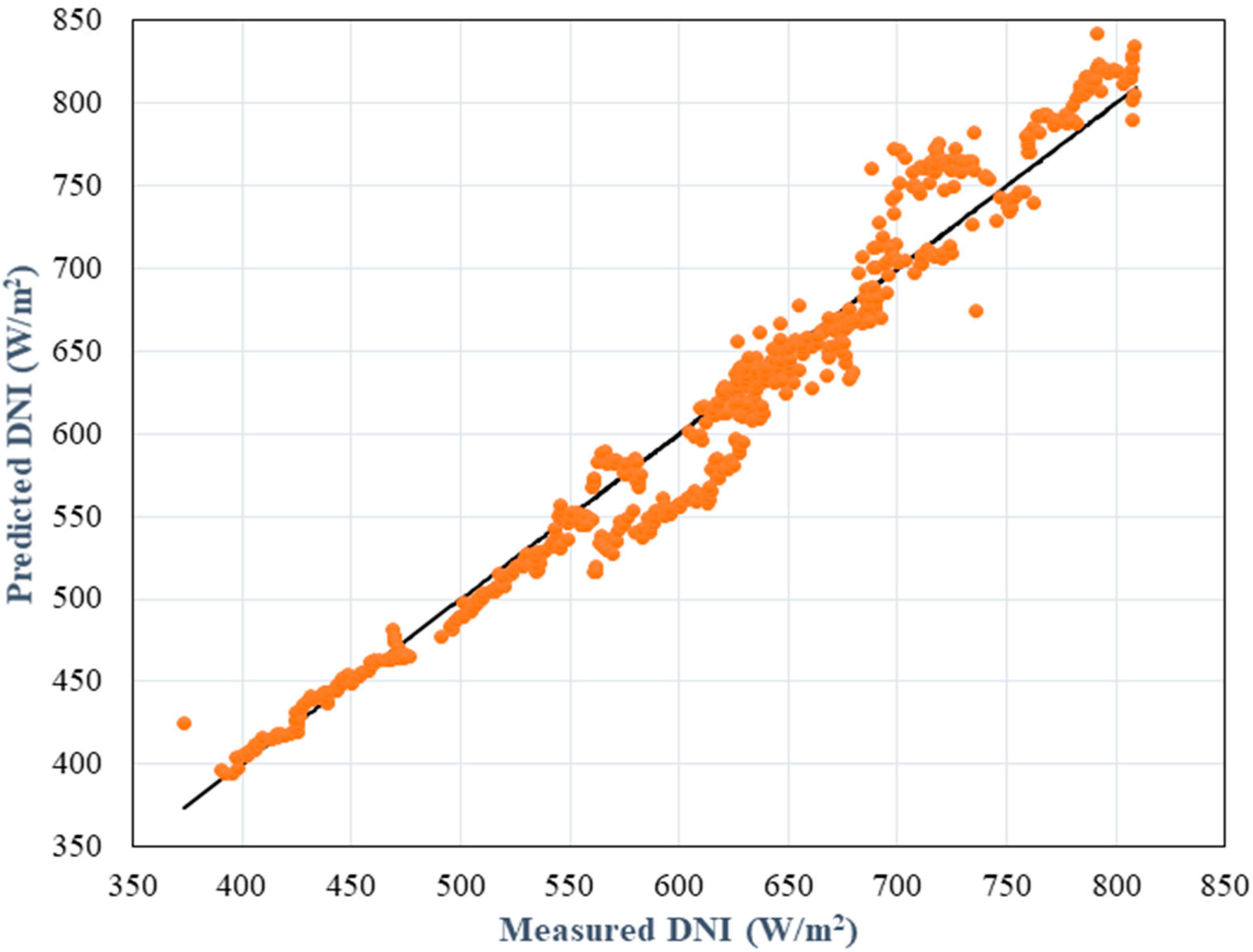

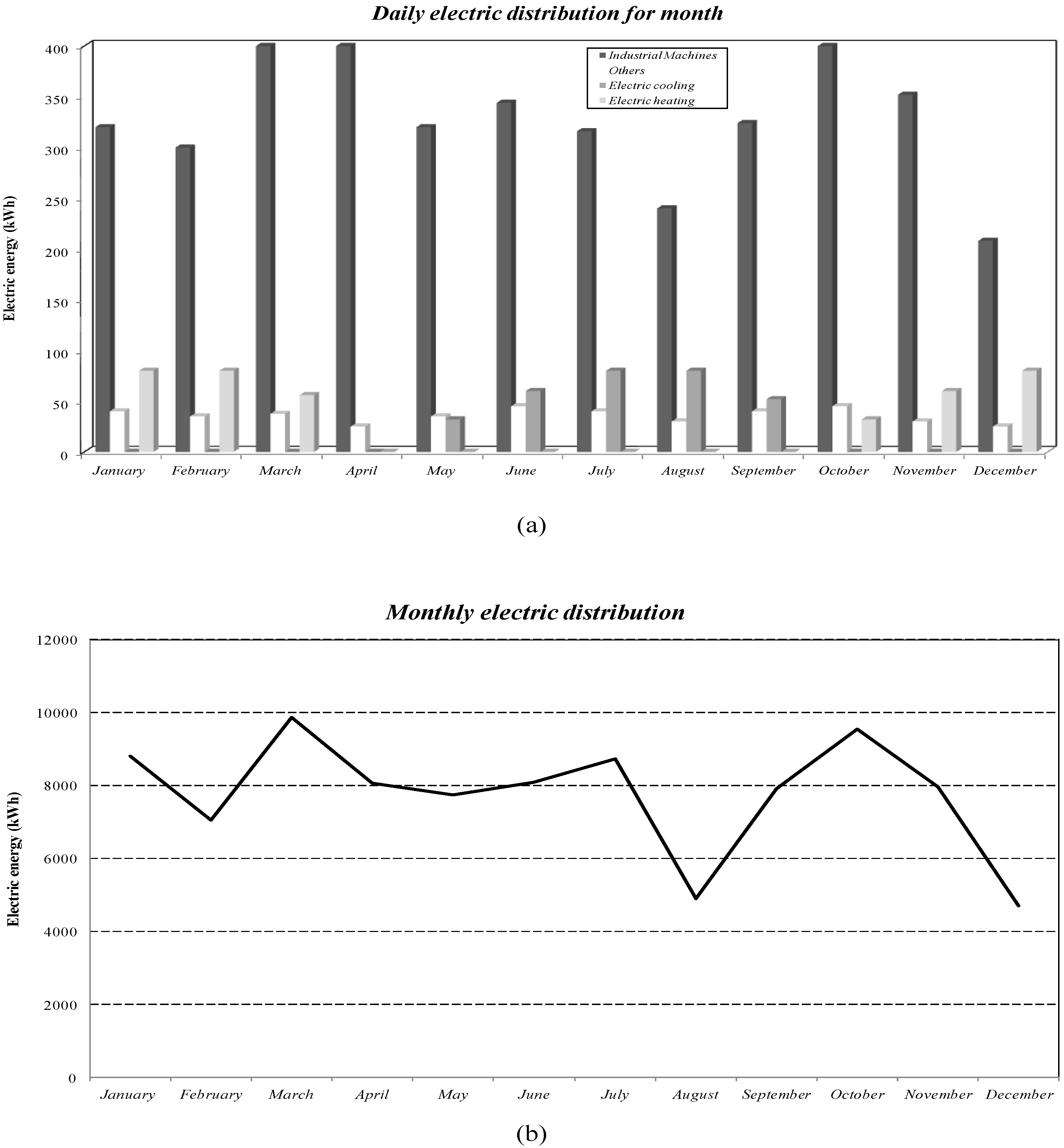
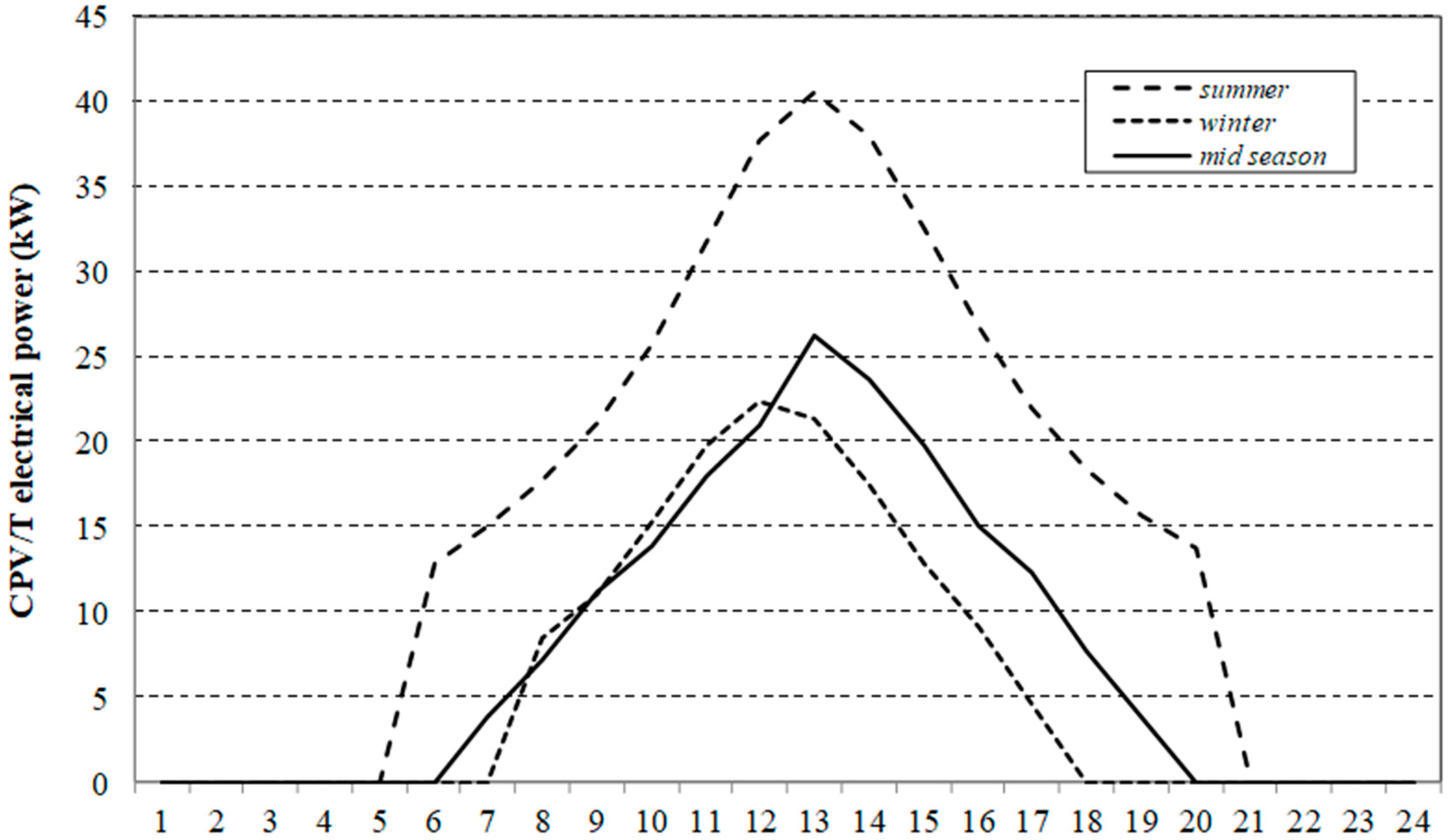
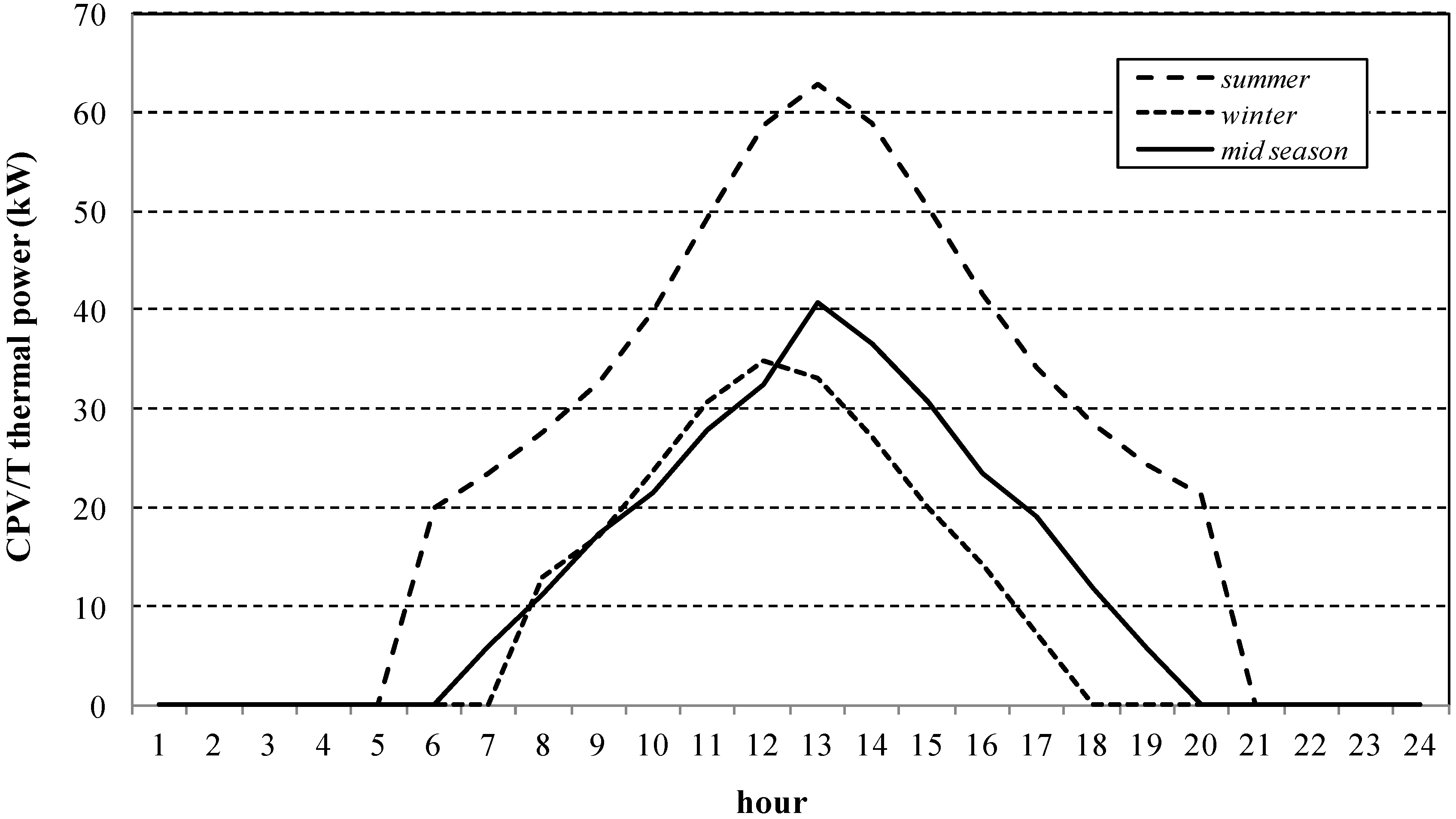
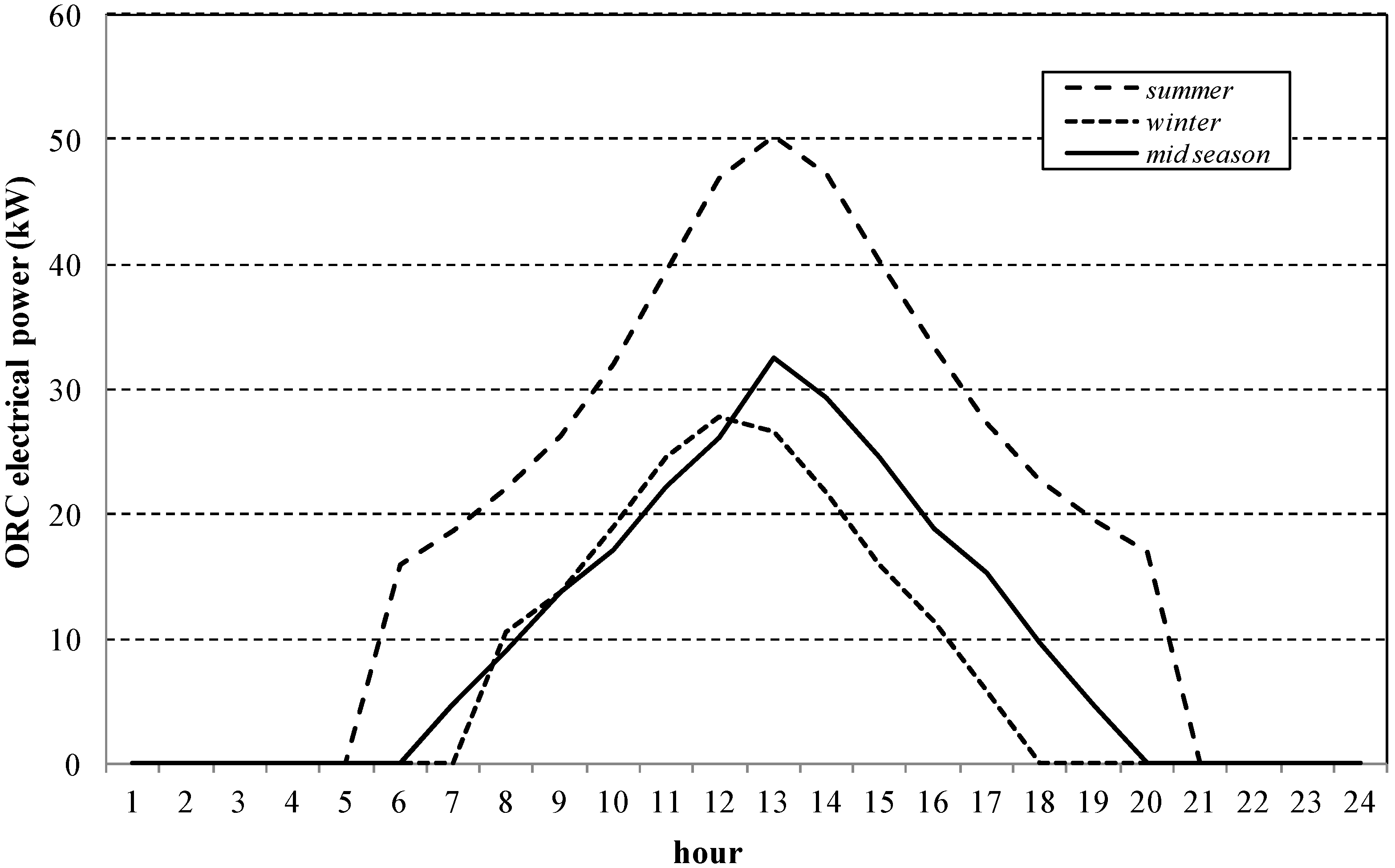
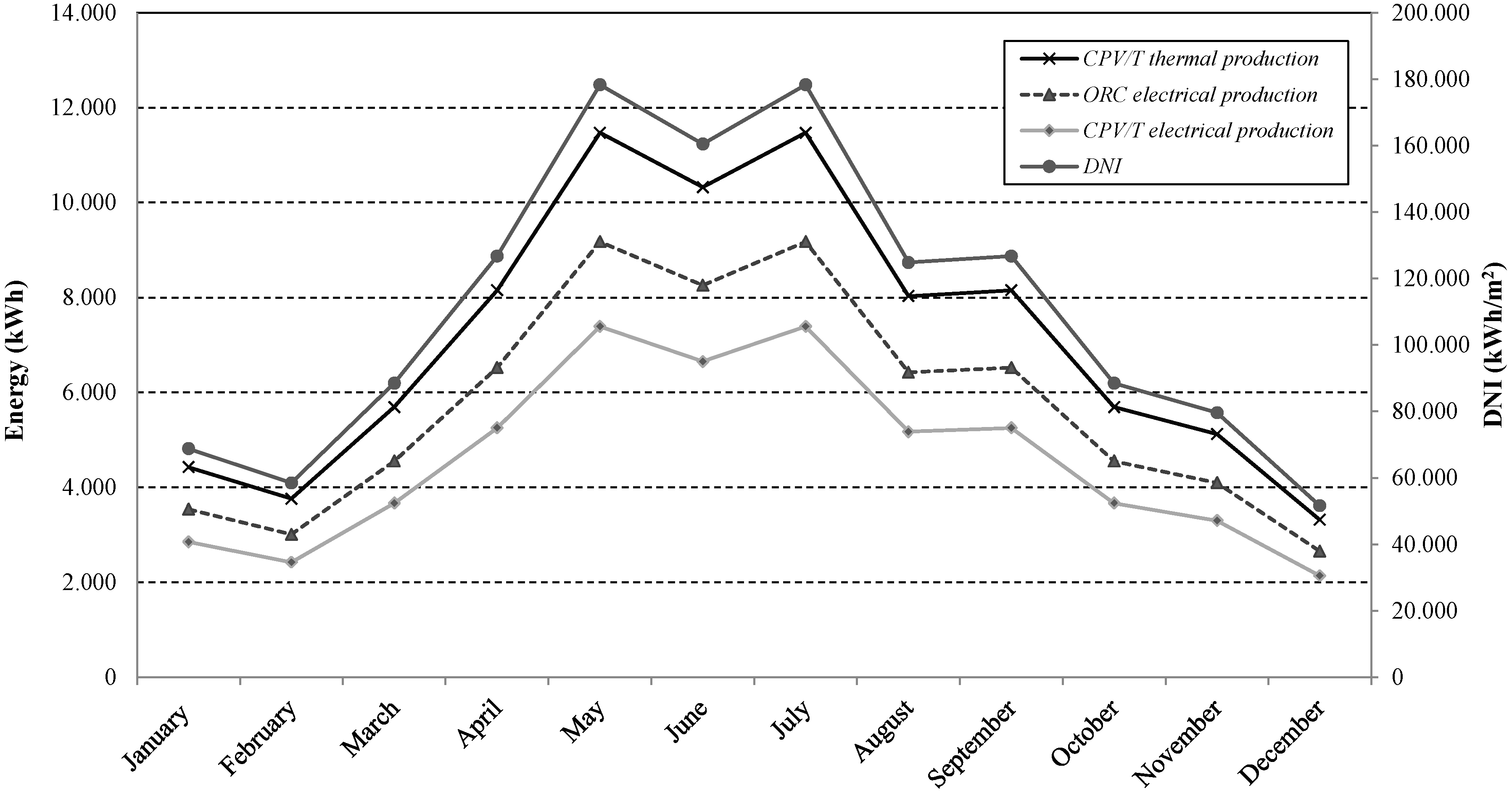
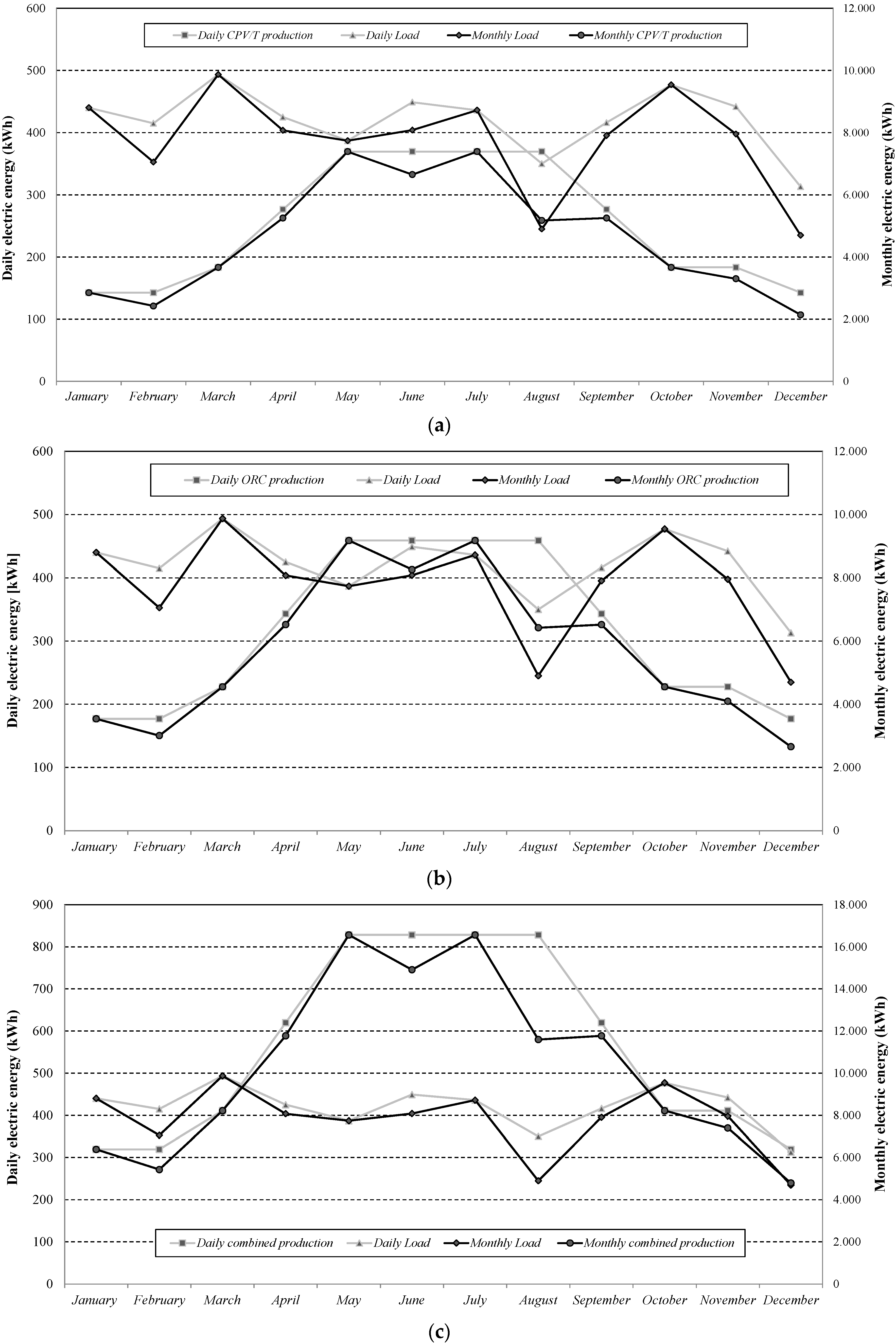
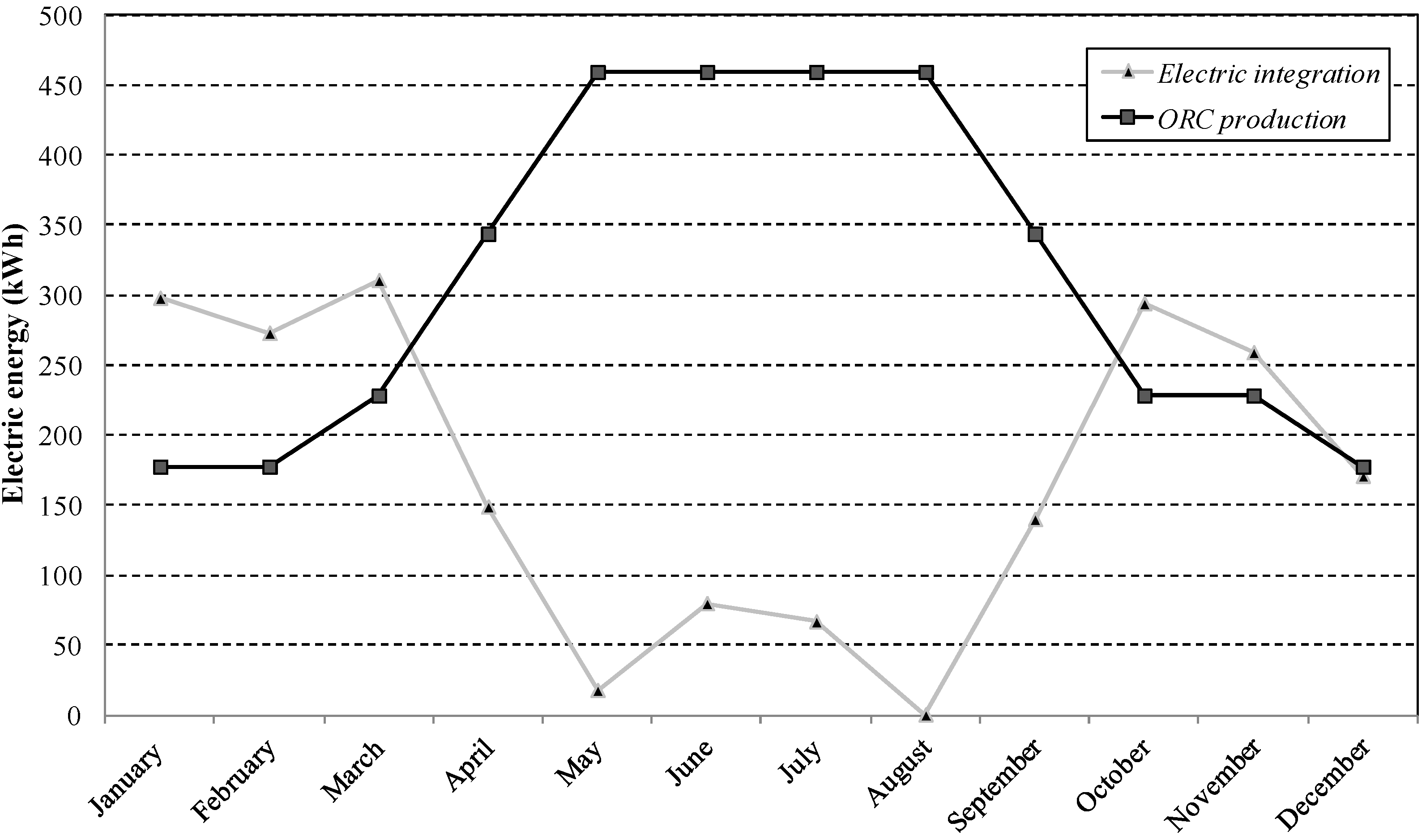
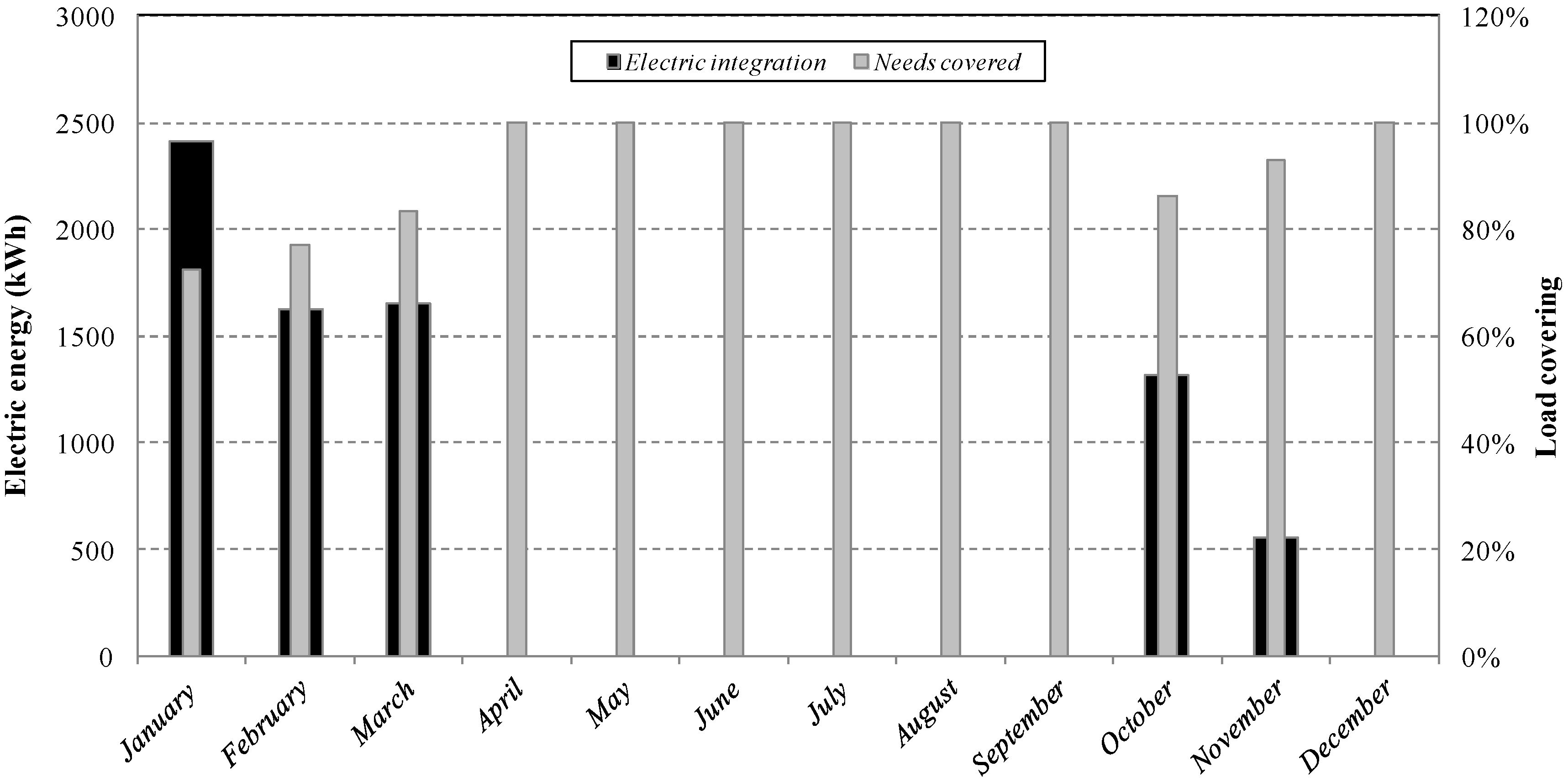
| Parameter | Value |
|---|---|
| material | InGaP/InGaAs/Ge |
| dimensions | 1.0 × 1.0 cm |
| (at 25 °C, 50 W/cm2–1000 suns) | 39.0% |
| temperature coefficient () | −0.04%/K |
© 2020 by the authors. Licensee MDPI, Basel, Switzerland. This article is an open access article distributed under the terms and conditions of the Creative Commons Attribution (CC BY) license (http://creativecommons.org/licenses/by/4.0/).
Share and Cite
Renno, C.; Petito, F.; D’Agostino, D.; Minichiello, F. Modeling of a CPV/T-ORC Combined System Adopted for an Industrial User. Energies 2020, 13, 3476. https://doi.org/10.3390/en13133476
Renno C, Petito F, D’Agostino D, Minichiello F. Modeling of a CPV/T-ORC Combined System Adopted for an Industrial User. Energies. 2020; 13(13):3476. https://doi.org/10.3390/en13133476
Chicago/Turabian StyleRenno, Carlo, Fabio Petito, Diana D’Agostino, and Francesco Minichiello. 2020. "Modeling of a CPV/T-ORC Combined System Adopted for an Industrial User" Energies 13, no. 13: 3476. https://doi.org/10.3390/en13133476
APA StyleRenno, C., Petito, F., D’Agostino, D., & Minichiello, F. (2020). Modeling of a CPV/T-ORC Combined System Adopted for an Industrial User. Energies, 13(13), 3476. https://doi.org/10.3390/en13133476








